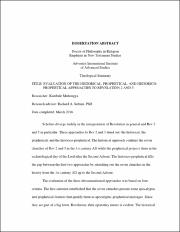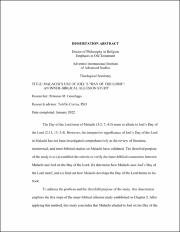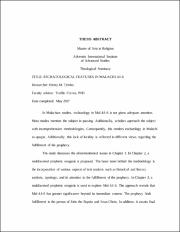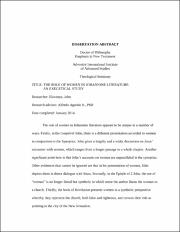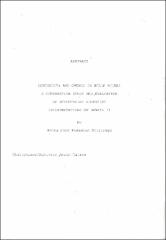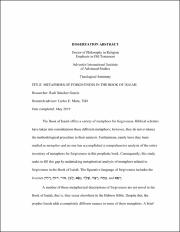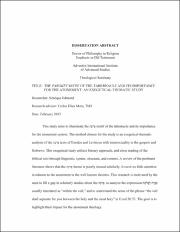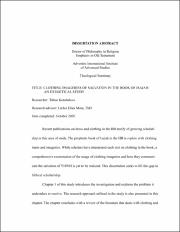Search
Now showing items 1-10 of 57
Evaluation of the historical, prophetical, and historico-prophetical approaches to Revelation 2 and 3
(Adventist International Institute of Advanced Studies, 2016-03)
Scholars diverge widely in the interpretation of Revelation in general and Rev 2
and 3 in particular. Three approaches to Rev 2 and 3 stand out: the historical, the
prophetical, and the historico-prophetical. The historical ...
Malachi's use of Joel's "day of the Lord" : an inner-biblical allusion study
(Adventist International Institute of Advanced Studies, 2022-01)
The Day of the Lord texts of Malachi (3:2, 7; 4:5) seem to allude to Joel’s Day of
the Lord (2:11, 13; 3:4). However, the interpretive significance of Joel’s Day of the Lord
in Malachi has not been investigated comprehensively ...
Eschatological features in Malachi 4:1-6
(Adventist International Institute of Advanced Studies, 2017-05)
In Malachian studies, eschatology in Mal 4:1-6 is not given adequate attention. Most studies mention the subject in passing. Additionally, scholars approach the subject with incomprehensive methodologies. Consequently, ...
The Role of women in Johannine literature : an exegetical study
(Adventist International Institute of Advanced Studies, 2014-01)
The role of women in Johannine literature appears to be unique in a number of ways. Firstly, in the Gospel of John, there is a different presentation accorded to women in comparison to the Synoptics. John gives a lengthy ...
Continuity and change in world rulers : a comparative study and evaluation of Seventh-day Adventist interpretations of Daniel 11
(Adventist International Institute of Advanced Studies, 2001-04)
Dan 11 is a prophecy about the forces of good and evil on the international scenario from
the time of Daniel until the end. The message of this revelation summarizes and expands the
preceding visions of Dan 2, 7, 8 and ...
Toward a biblical theology of homosexuality : Old Testament contributions
(Adventist International Institute of Advanced Studies, 2021-11)
The two primary objectives of this research are (a) to solve several interpretive
problems presented by various OT interpreters over prohibition texts and their
challenging passages, which seem to discuss homosexuality ...
Metaphors of forgiveness in the book of Isaiah
(Adventist International Institute of Advanced Studies, 2019-05)
The Book of Isaiah offers a variety of metaphors for forgiveness. Biblical scholars
have taken into consideration these different metaphors; however, they do not evidence
the methodological procedure in their analysis. ...
The PAROKET motif of the tabernacle and its importance for the atonement : an exegetical-thematic study
(Adventist International Institute of Advanced Studies, 2015-02)
This study aims to illuminate the פָּרכֶֹת motif of the tabernacle and its importance
for the atonement system. The method chosen for the study is an exegetical-thematic
analysis of the פָּרכֶֹת texts of Exodus and ...
Clothing imageries of salvation in the book of Isaiah : an exegetical study
(Adventist International Institute of Advanced Studies, 2020-10)
have interpreted each text on clothing in the book, a
comprehensive examination of the usage of clothing imageries and how they communicate
the salvation of YHWH is yet to be realized. This dissertation seeks to fill ...
A Model for effective ministerial program in the Philippines and Ghana Union Conferences : a multiple case study
(Adventist International Institute of Advanced Studies, 2021-05)
The global Seventh-day Adventist Church mission to bring the everlasting gospel
to all the world and to reach the level of every audience is an arduous task. This mission
requires a great amount of knowledge and skill ...

